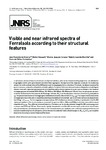Use este identificador para citar ou linkar para este item:
http://www.alice.cnptia.embrapa.br/alice/handle/doc/1059216Registro completo de metadados
| Campo DC | Valor | Idioma |
|---|---|---|
| dc.contributor.author | OLIVEIRA, J. F. de | pt_BR |
| dc.contributor.author | BROSSARD, M. | pt_BR |
| dc.contributor.author | CORAZZA, E. J. | pt_BR |
| dc.contributor.author | MARCHAO, R. L. | pt_BR |
| dc.contributor.author | GUIMARÃES, M. de F. | pt_BR |
| dc.date.accessioned | 2016-12-23T11:11:11Z | pt_BR |
| dc.date.available | 2016-12-23T11:11:11Z | pt_BR |
| dc.date.created | 2016-12-23 | pt_BR |
| dc.date.issued | 2016 | pt_BR |
| dc.identifier.citation | Journal of Near Infrared Spectroscopy, v. 24, n. 3, p. 243-254, March 2016. | pt_BR |
| dc.identifier.uri | http://www.alice.cnptia.embrapa.br/alice/handle/doc/1059216 | pt_BR |
| dc.description | ABSTRACT: In soil science, structural features of soils are an important attribute; soils can be characterised by proportional size distribution of aggregates and the pore space between and within those aggregates. The objective of this study was to evaluate the relationship between the visible and near infrared (Vis?NIR) spectra and microaggregates from a collection of Ferralsols. Our dataset consists of 56 spectra from seven soil profiles of kaolinitic and oxidic-gibbsitic Ferralsols. Soils were characterised according to their morphological features: those with a typical porous massive structure and those with a cohesive massive structure. Size distribution of five classes of microaggregate was determined (1000?2000 µm, 500?1000 µm, 250?500 µm, 105?250 µm and < 105?µm). From the soil spectra, we determined the CIE (Commission Internationale de l'Éclairage) red index (RICIE) and the absorption intensities of kaolinite (IKa) and gibbsite (IGb). The predominant fraction of microaggregates exhibited sizes between 250 and 1000µm (Φ250?1000). The proportional increase of this microaggregate class in the soils increased the scattering and variability of reflected light, particularly when soil samples showed more than 0.50 g g?1 of Φ250?1000. The microaggregate size explained over 55% of reflectance intensity variability of wavelengths in the vis?NIR regions, principally on reflectance intensity and concavity of the spectra at 436 nm, 546 nm and 2236 nm, which decreases with increased proportion of Φ250?1000. Thus, different structural features of Ferralsols can be directly evaluated through Vis?NIR spectroscopy, even in samples sieved through 2.00 mm. These results highlight the potential use of Vis?NIR spectroscopy in studies of soil classification, soil physical behaviour and soil physical fertility and environmental studies, principally by a new method of analysing bulk density and structure of soil directly from the soil spectra, without the need for predictive models. As well as spectra, RICIE,IKa and IGb can be used to characterise the different structural features of Ferralsols. | pt_BR |
| dc.language.iso | eng | eng |
| dc.rights | openAccess | eng |
| dc.subject | Espectroscopia de refletância difusa | pt_BR |
| dc.subject | Microped | pt_BR |
| dc.subject | Solo mineral | pt_BR |
| dc.subject | Diffuse reflectance spectroscopy | pt_BR |
| dc.subject | Latosol | pt_BR |
| dc.subject | Soil mineral | pt_BR |
| dc.title | Visible and near infrared spectra of Ferralsols according to their structural features. | pt_BR |
| dc.type | Artigo de periódico | pt_BR |
| dc.date.updated | 2017-01-09T11:11:11Z | pt_BR |
| dc.subject.thesagro | Estrutura do Solo | pt_BR |
| dc.subject.thesagro | Latossolo | pt_BR |
| dc.subject.nalthesaurus | Soil structure | pt_BR |
| riaa.ainfo.id | 1059216 | pt_BR |
| riaa.ainfo.lastupdate | 2017-01-09 | pt_BR |
| dc.identifier.doi | https://doi.org/10.1255/jnirs.1202 | pt_BR |
| dc.contributor.institution | José Francirlei de Oliveira, Universidade Estadual de Londrina; Michel Brossard, IRD (Institut de recherche pour le développement); EDEMAR JOAQUIM CORAZZA, SCT; ROBELIO LEANDRO MARCHAO, CPAC; Maria de Fátima Guimarães, Universidade Estadual de Londrina. | pt_BR |
| Aparece nas coleções: | Artigo em periódico indexado (CPAC)  | |
Arquivos associados a este item:
| Arquivo | Descrição | Tamanho | Formato | |
|---|---|---|---|---|
| Oliveiraetal2016.pdf | 1,66 MB | Adobe PDF |  Visualizar/Abrir |









